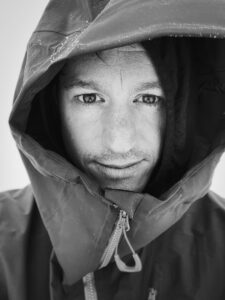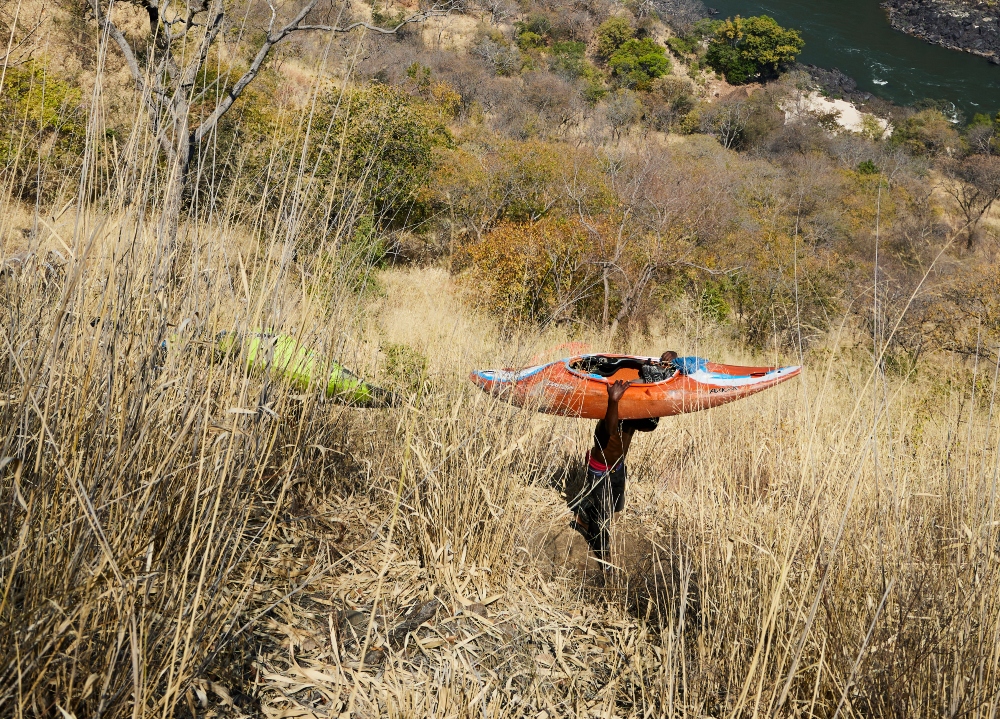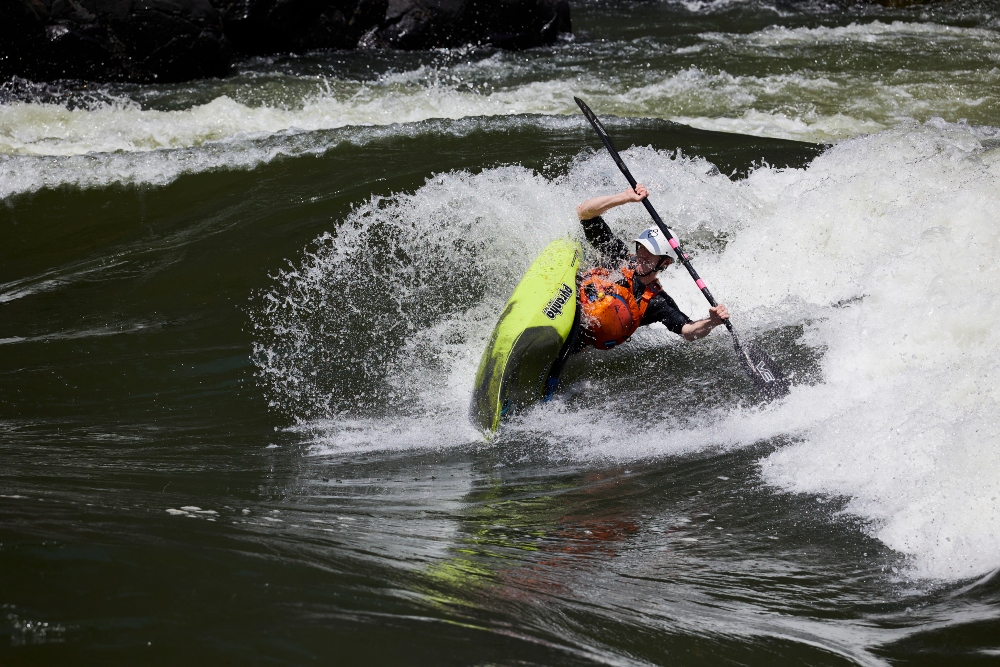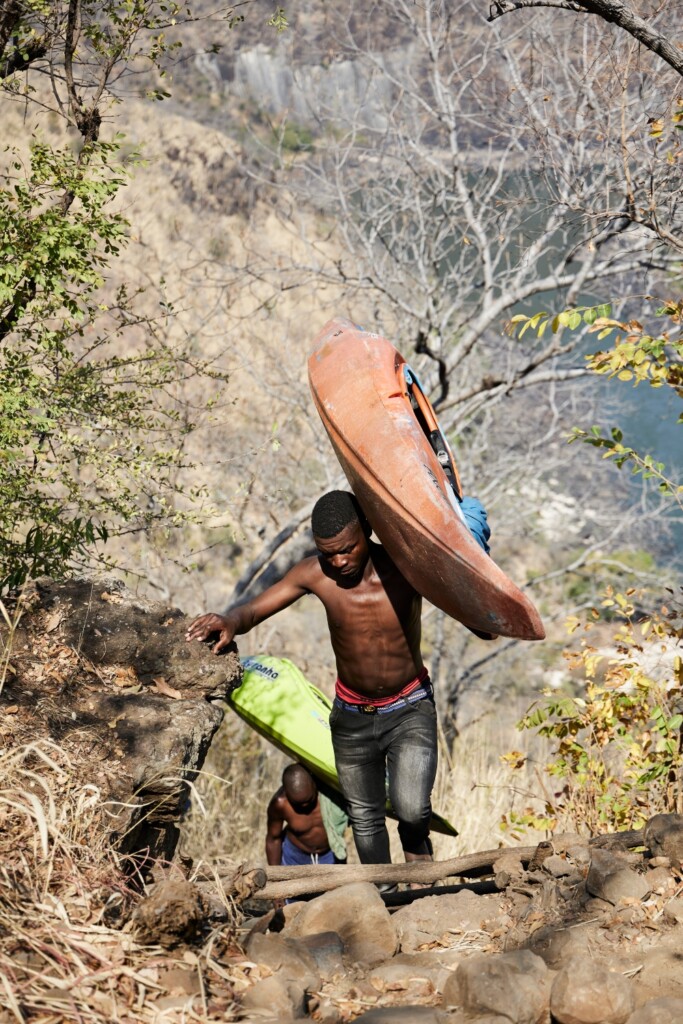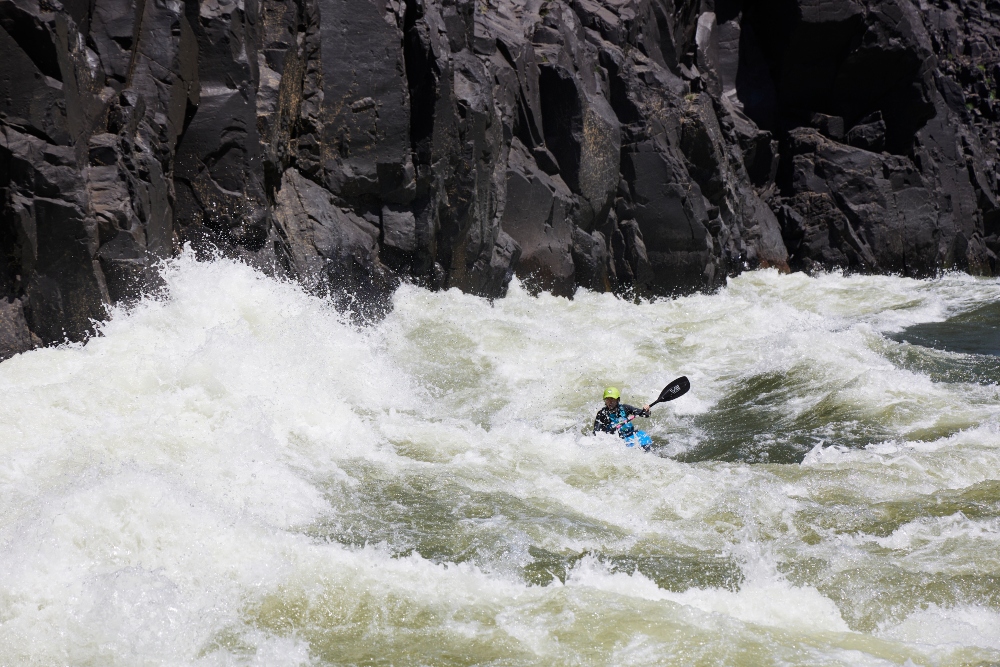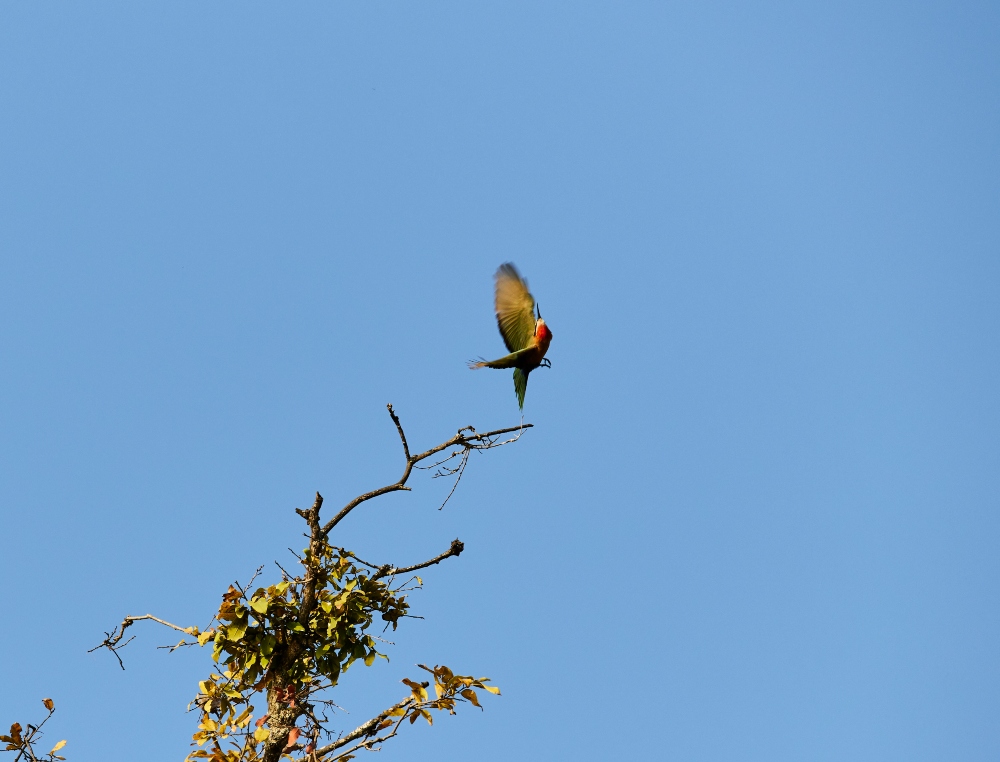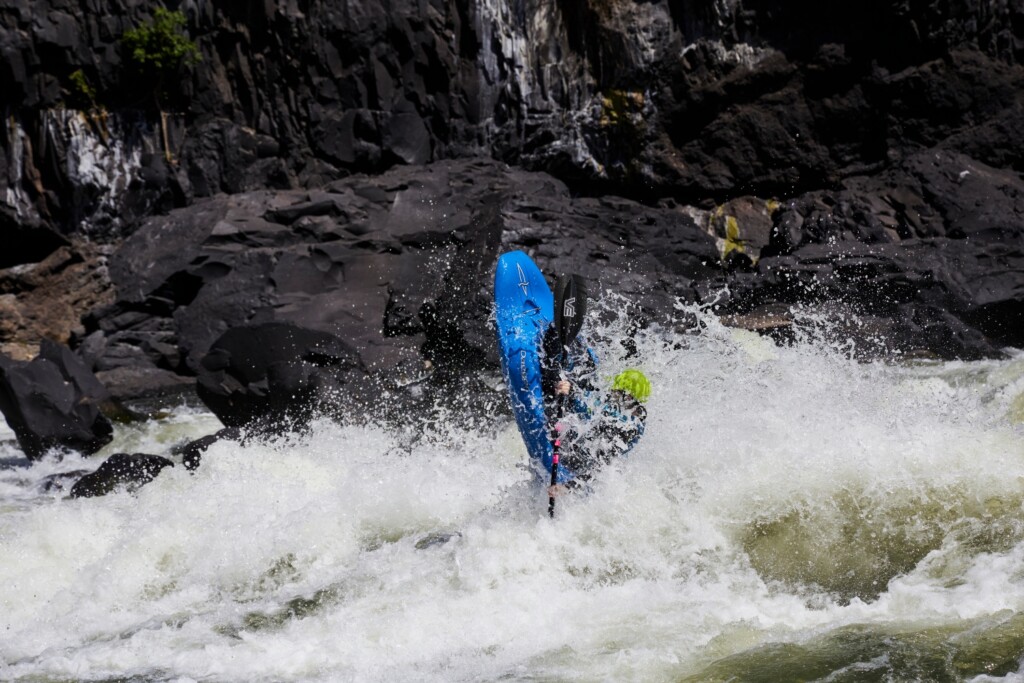Home to Victoria Falls and some of the world’s most famous whitewater, at 1,599 miles long, the Zambezi is Africa’s fourth longest river. But a dam proposal places its waters, wildlife and tourism economy under threat. Exploring his own connection to the river and what damming it could mean, former professional whitewater kayaker and BASE Collective member Ed Smith makes the long-anticipated journey to ride the whitewater of the Zambezi before it is gone for good.
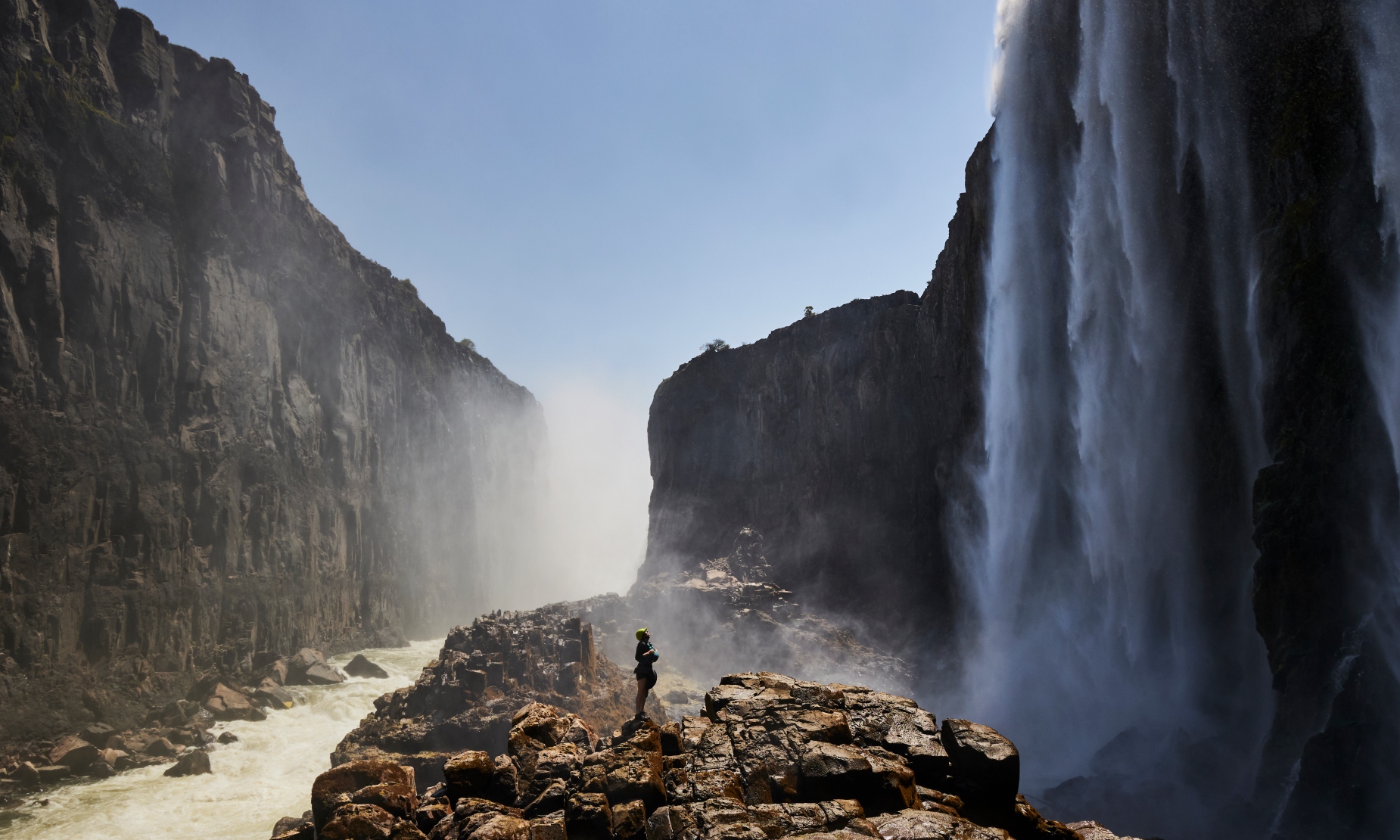
Alex Crawley amongst the mist looking up to the lip of Victoria Falls with the thundering Minus Rapids behind her. For two decades I had dreamed about making it to this location. It didn’t disappoint. The experience was made extra special to be the only people there with the access of our kayaks.
Running rivers before they are dammed has become the perpetual chase of the international whitewater kayaker. But navigating the experience without falling in love with both the river and its surrounding community is tricky, at times traumatic.
After witnessing the demise of the White Nile to large-scale hydro, followed by a twelve-year hiatus from international kayaking, I finally made the pilgrimage to the Zambezi. Images of this river have captivated me since my early teens. Re-entering this world of whitewater created a surge of passion to pair my experience as a photographer with my experience as a kayaker in order to document such environments as closely as I can. In trying to understand what hangs in the balance for this environment and its culture, I have never felt more hopeful that the local voice is being transmitted. But is it being heard?
Few rivers make their presence known so distinctly whilst remaining hidden from sight – tucked in a cleft scored into an immense open plain, the mist rises and the drum beats louder than ever. I’m here, and whilst I won’t see the river until tomorrow morning, as the vapour rises above where I know Victoria Falls to be, the anticipation of what the Zambezi holds in store for me builds. The same images I obsessed over as a teenager, along with those very first beats of the drum, now flick through my mind.
I feel the heat on my skin – inhale – I take in the sensation of finally being here. My girlfriend Alex is sitting beside me ‘Africa looks great on you,’ she says with a smile as we roll into Livingstone, Zambia. Whilst I’ve never been here before, I have that strange sensation of content that comes from arriving on familiar grounds. Our driver pulls me out of my reverie, advising us to buy Nyami Nyamis – carved pendants of the serpent river god – before getting on the river. This deity is said to have flooded the river in the 1950s in response to the Kariba dam which separated him from his sweetheart downstream. We’ll take all the help we can get.
Before we head into the Batoka Gorge, let me take you back some years, beyond the start of the beating drum of the Zambezi, to when this sense of needing to chase rivers took hold. ID2 by Shaun Baker was the first kayak movie I ever bought. It followed an unusual storyline of kayakers running man-made dams and weirs, prophesying of a sport that would fall into folklore after the rivers had all been dammed. It was a sad vision but one that clearly left its mark. As a remedy, I bought a second kayak movie, Wicked Liquid II, which showcased the kayaking elite of the era weaving through huge crashing rapids of the White Nile and Zambezi. Hooked, I set about manifesting a cold (faked is such a strong word) to allow me the next day off school so I could commit the moves and belting tunes to memory. Kayaking these rapids struck me as the perfect ambition… likely more than my careers advisor could cope with. The most chaotic, noisy, thrashing playground imaginable. Perfect.
Fast-forward to my late teens and I was logging formative trips to the White Nile. As was the case for many others, my connection with the river grew incredibly strong; it soon became a home from home. The river built a visibly progressive economy that saw local villagers go from small-scale subsistence farmers to also becoming crafts people, raft porters, safety kayakers, raft and kayak guides. Other members of the community went from pedalling bicycle boda-bodas (push-bike taxis) to mopeds and cars, taxiing more people, longer distances and so on. How sad, then, to witness the start of its slow decline. In 2007, we’d be floating past a regularly kayaked channel, blocked by the first half of a hydro mega structure. It’s certainly the most acute, tangible environmental travesty I’ve witnessed in person; a natural beauty carved by the ebb and flow of nature over millennia, cut-off in the blink of an eye. The estimated lifespan of this dam is 50 years, which seems futile, already foretelling of another unnecessary dam in its wake.
But that was then and this is now. The rapids of the Zambezi still have a chance of survival, and I like to think that the odds are good.
Kayaking these rapids struck me as the perfect ambition… likely more than my careers advisor could cope with
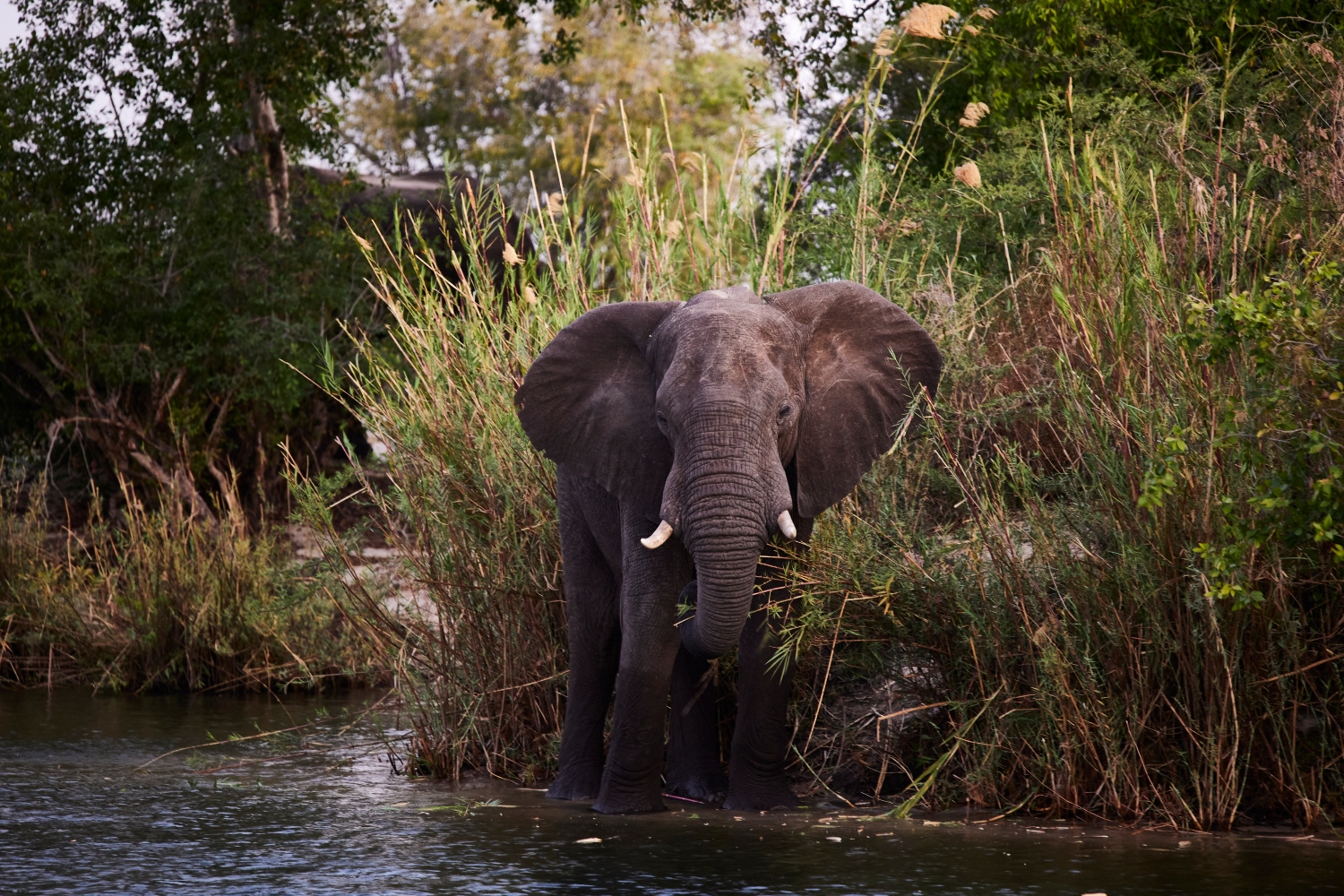
Rolling to the river each day, it was so common to see this herd of elephants or at least signs of their journey.
Sat in the dusty pickup with kayaks overhanging the tailgate, we’re acutely aware of our heightened senses; of everything we see, hear and feel. Both Alex and I have a level of apprehension for different reasons. Alex is a highly capable kayaker with experience of Scottish and Alpine rivers, which run at volumes in the 10-50 cubic metres per second (cumecs) range. The Zambezi weighs in at approximately 500 cumecs for its rafting season. This puts it in the category of ‘big water boating’ and this is a perfect practice ground. Alex knows that in the next few hours, she’ll be getting her first taste of floating over the threshold into rapids that will crash overhead, hurl us over backwards, wrench at our paddles and blast out our sinuses – not necessarily in that order. I can see her picturing it in her mind. Imagine the sensation of queuing for a particularly terrifying roller coaster, then imagine that 21 times in a row. Take away the safety net, forget about the control switch and swap out the manmade rail and electrics with the raw power of nature and gravity behind you. Part of the apprehension in these lulls, as you approach something daunting with so much time to think, is second guessing what your reactions might be; Will I be able to paddle hard enough? Will I freeze up? Will I get a thrashing? Will I be able to roll back up? In big water the answer is ‘time will tell’. I have every confidence in Alex’s ability, and I’m excited to see her build that confidence herself.
Whilst I used to consider such rapids as my natural playground, my apprehension today revolves around questioning if I might have lost something in the interim. I can assuage the fact I’ll be rusty by setting my expectations appropriately and not ‘going too big, too soon’. Having been privileged enough to grow up kayaking and canoeing, ‘home’ to me has always been connected to the closest waterway. Journeying on the water has always felt natural, some of my earliest memories are of fishing off the back of a canoe with my parents. That connection is what I’m afraid I might have misplaced, as my relationship with water has felt somewhat hot and cold in the last decade, as I’ve spent more time looking to the mountains (can’t build dams up there!) and creatively immersing myself as a self-employed adventure photographer.
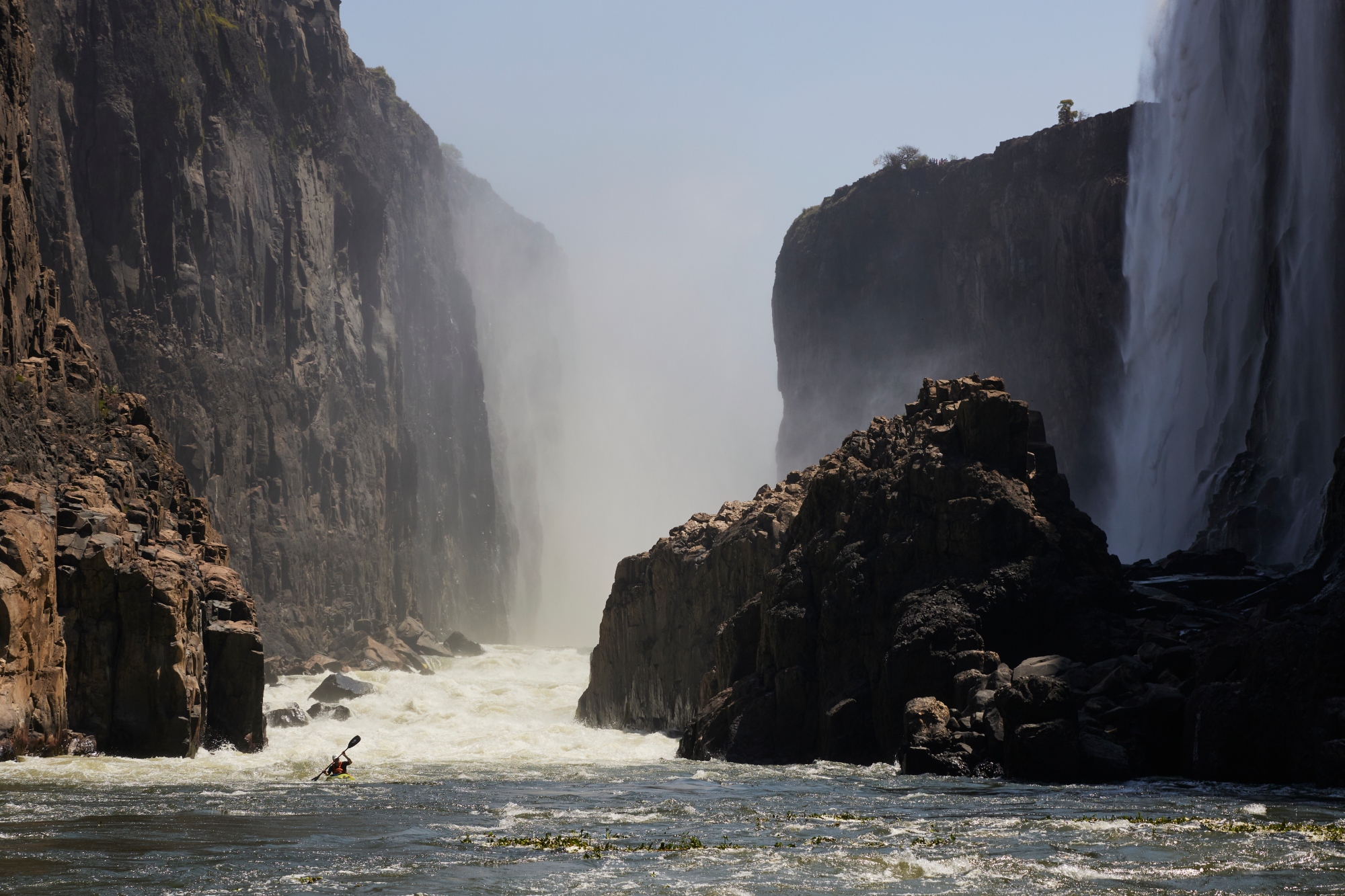
Ed enjoying the ‘The Boiling Pot’, where the water continues to bubble and crash, having cascaded down Victoria Falls and the Minus Rapids.
Having bought Nyami Nyamis from our porters James and Manyando, we set about a sweaty warm-up before tucking knees into our boats and straining our sprayskirts on. The first splash of warm water as we slide off the rocks reminds us that this is in fact, very much not home. So too does the massive train of waves emerging from Rapid #1, which we need to cross to gain access to the gorge proper. It’s an intimidating first move as the waves pummel straight into a rock wall, causing a lot of messy, reactionary whitewater – exactly where you don’t want to be.
Set to make the move, we hear a blood-curdling scream. We look up to see a bungee-jumping backpacker mid-leap from the Victoria Bridge, followed by a massive bellowing jet-boat, hooning up the rapid. There’s a lot going on here, and whilst there’s a lot to be said for the tourism on offer, at this exact moment in time I’d love it all to bugger off. Alex and I chat about the timing as we watch friends we’ve met from New Zealand and Colorado navigate across the train of waves with varying degrees of success.
As I peel into the slack water on the other side, I turn with my heart in my mouth to see Alex side-on, getting wiped out by a wave. It’s one of the toughest positions from which to roll up, but she gets her head above water just enough for some air before getting wiped out by the next one. From there she’s fed into the crashing waves and boils. I count six rolls as she’s thrashed around and the whole crew of us start paddling towards what we assume will be a swimmer, just as Alex makes her seventh roll. Gasping for breath she’s wide-eyed, rearranging her helmet and buoyancy aid after the river’s best efforts to strip them off. ‘I don’t know what happened there but that wave hit me so hard. My earrings are gone and the string on my Nyami Nyami snapped’. Alex had been tested, and in full view of an international crew of kayakers who immediately tipped their hats. Witnessing her resilience, they acknowledge they would have likely ejected in the same situation. It was incredible to see her come out the other side with such composure.
The rapids of the Zambezi still have a chance of survival, and I like to think that the odds are good
On Rapid #7, Gulliver’s Travels, my own form and awareness came to light. Whilst not the biggest, this is perhaps the longest rapid on the section. From the riverbank, our local guide Amioty had talked me through the crux of the line, a ‘thread the needle’ kind of move around a crashing wave-hole you don’t want to be in, to then cut above a jagged rock feature you didn’t want to be on. Crucially, I forgot to recalibrate my distanced perspective from the riverbank to how small I’d actually be in the rapid (hence its name). I also hadn’t taken note of a section known as Land of the Giants lurking just beyond it. My descent was successful but nevertheless enlightening, as with thoroughly cleaned eyeballs I resolved to adjust my perspective.
Rapid #5, Stairway to Heaven gave us a highlight on every descent. Being of the straight-forward but massive variety, cresting the brow as it comes into full view, it never fails to take the breath of its paddlers. On her first descent, Alex paddled down as if it were a ripple whilst the rest of us were thrown left right and centre – as would be the case for me until our very final descent. The most continuous section of rapids – #11, #12, #12b always posed a bit of a workout with currents pushing in all directions before feeding you into #13 The Mother. Getting down this without rolling became one of Alex’s targets for the trip; no mean feat being that it was one of the biggest rapids and she was in the smallest boat on the river.
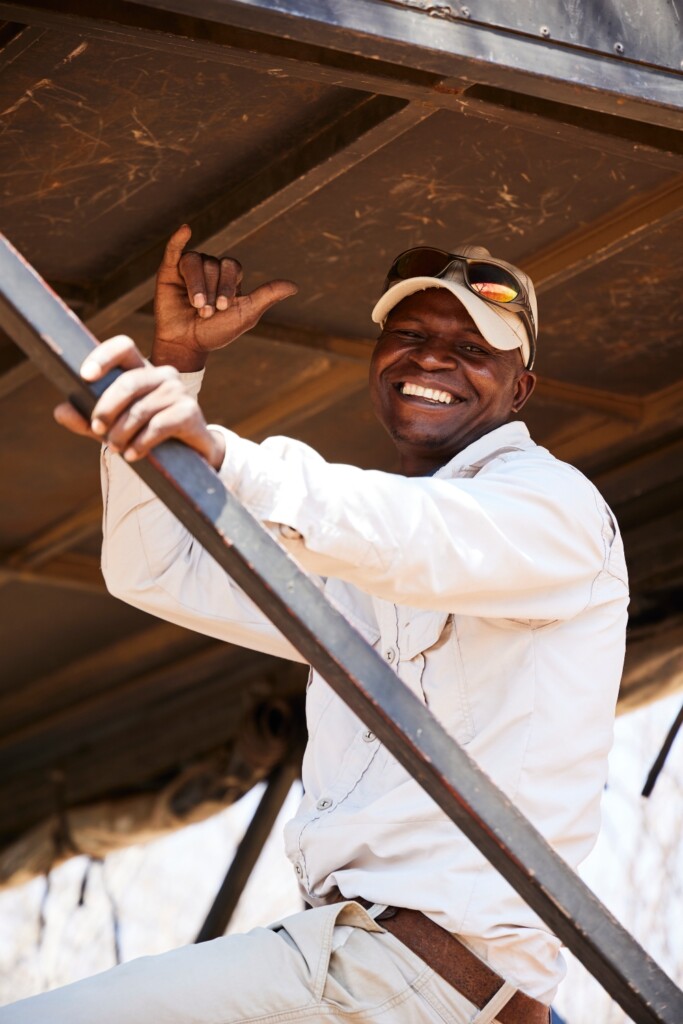
Benjamin, what a legend! A driver for local outfit ‘SafPar’, each day he’d drop us and the other kayakers off, and organise porters to get us into the gorge. Then, in the afternoon, once we’d made the strenuous hike back out, he’d meet us with the most thirst quenching cooler of soft drinks. He’s currently learning to kayak with his eyes on being a safety boater and guide.
In the lower section of the gorge, we encountered crocodiles on the banks but to our relief they always remained inactive, choosing to sun themselves over making any move towards us. The thought of their presence was only heightened on a couple of descents we did alone as a pair. Without the noise of a group or rafts nearby, we were particularly vigilant but never felt anything other than the joy of seeing wild animals in their natural habitat. As was the case for the baboons who roamed the gorge, even if they did seem particularly judgemental were you to scout or walk a rapid along their bank, and I don’t know anyone who would tire of seeing wild elephants on the way to the river every day. These experiences served to enforce the sense that this is far more than just our playground. This is a habitat, one in which some come to work and we have come to play.
Each day our boats were portered in and out of the gorge for us as part of the organisation of the local tourism economy. To refuse a porter your boat when kayaking the Zambezi would be akin to not employing Sherpas in the Himalayas. Navigating the steep staircases built of natural branches and twine was a daily obstacle, jokingly deemed ‘the most dangerous part of the day’ by one of our friends from Colorado. Yet our porters would do it in flip-flops, sometimes with a kayak on each shoulder. We were always in awe. We shuttled to and from the river each day using local adventure outfit Safpar who employed local drivers, local guides and local porters. They’d also drop a sat-phone with the last group on the water each day – good peace of mind, which did come in handy for a kayaker who had a shoulder dislocation and needed evacuating from the gorge on our first day.
With thoroughly cleaned eyeballs I firmly resolved to recalibrate my perspective
Jollyboys hostel is synonymous with the Zambezi amongst kayakers, and riding back to our base there, along the rutted and dusty roads, actually felt like the icing on the cake after each day on the water. It was a time to relax, reflect and chat whilst passing through remote local villages, often dropping off our porters and guides along the way or picking up their children and other members of the family, who might become the porters or kayak guides of the future.
On one journey I asked a guide Julius about the river and what it means to him: ‘Since the year 2000 the Zambezi has been my life, it has given me a huge amount – as the source of my living it’s helped me and my family survive financially and provided the opportunity to interact with people from all over the world. Without the Zambezi I wouldn’t be who I am today. I will always say no to the dam, because people will not come here, will not spend money here to see a river and environment that does not bring them joy’.
Both physically and figuratively we live a world away from each other, but in the Zambezi, we have more in common with these local friends than the organisations who threaten the communities, ecosystems and livelihoods that surround the river.
By simply understanding its most recent history and experiencing the river as it is, we can fathom the importance of protecting the Batoka Gorge of the Zambezi. It has to be saved. Because if it isn’t, there won’t ever be another one like it.
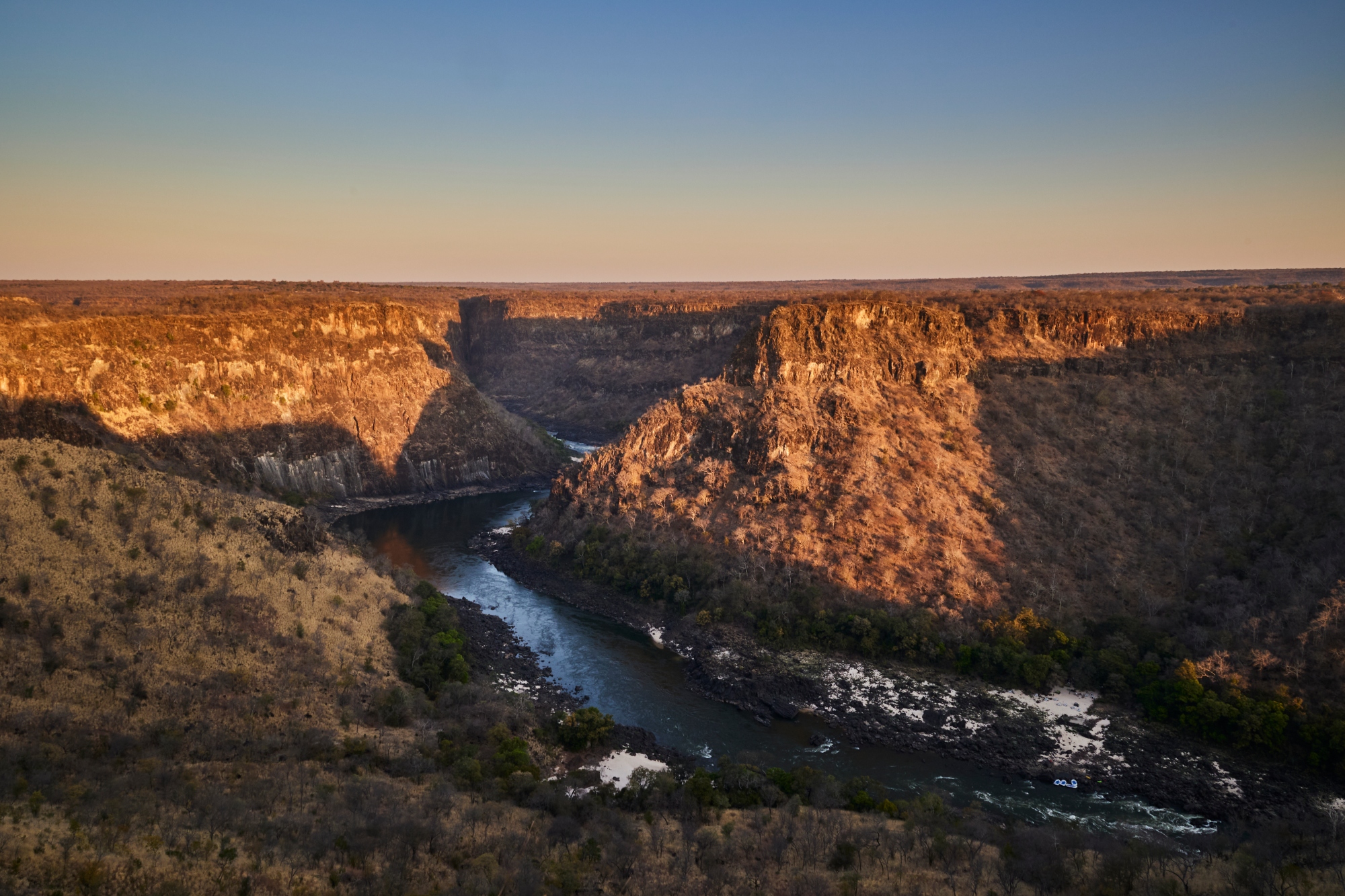
Sunset over the the bends of the Batoka Gorge from the top of the hike out.
The Dam Proposal
If funding is secured, construction of the new dam will take five to seven years. From consultations to date the proposed dam wall has reduced from 182m to 175m, which in theory means that rapids #1-#13 might still be navigable, but on the other hand this still might leave less than a handful of rapids.
Obviously this offers little environmental compromise, but feedback from the commercial activities around the river is also not fully understood. Whilst the ebb and flow of low and high water seasons currently offer a natural shift in feasibility and activities at different times of year, it is the length and variety of the Zambezi that leaves many options on the table for the economy around the river.
If the dam were to be erected then the offering would be significantly limited. As the director of operations at one outfit explained; ‘with only a few rapids left we would be limited to a low water season which would be very short and therefore limit our business model.’
In looking at such a seasonable model, there would be a spiral of logistical difficulties, such as less chance of retaining the likes of river and raft guides. Diversification would be limited as the lake created from the dam would be narrow and deep, not good for the likes of fishing, plus the mobility of the crocodile population, currently limited naturally by the course of the river, would heavily limit watersports participation.
For more information about the proposal and how to join the fight, click here.
Don’t miss a single adventure
Sign up to our free newsletter and get a weekly BASE hit to your inbox
You might also like
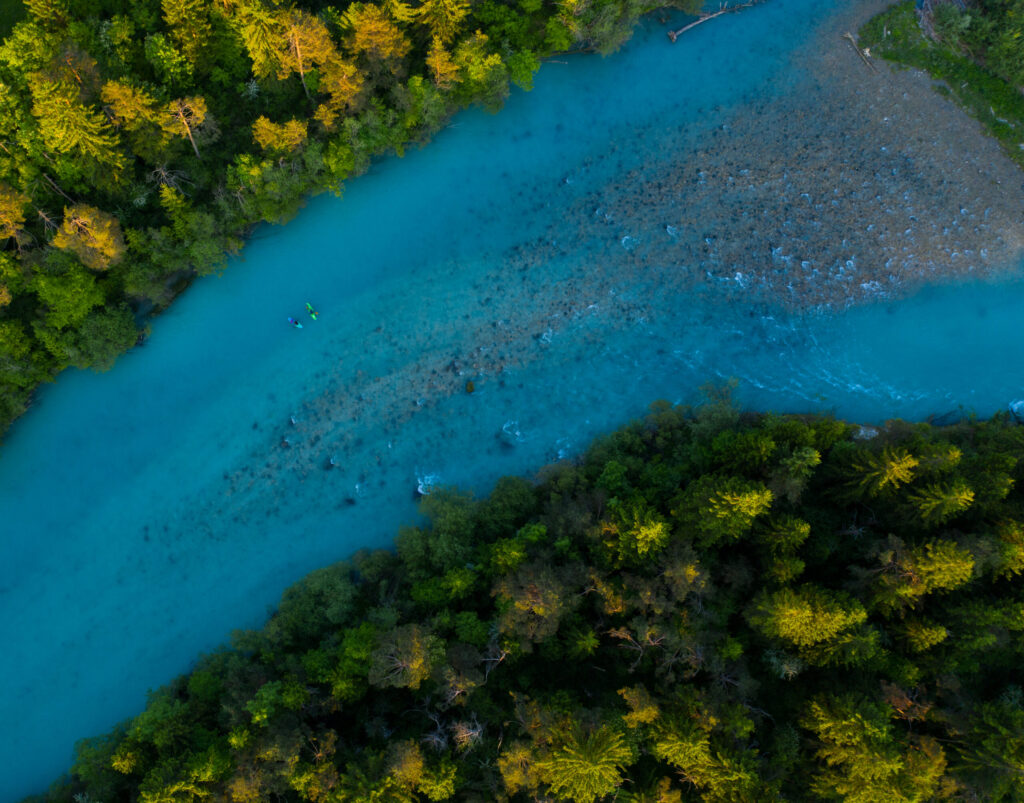
Story • Carmen Kuntz • Feb 18, 2022
One With The River
Whitewater kayaking and environmental action on Slovenia's Sava River
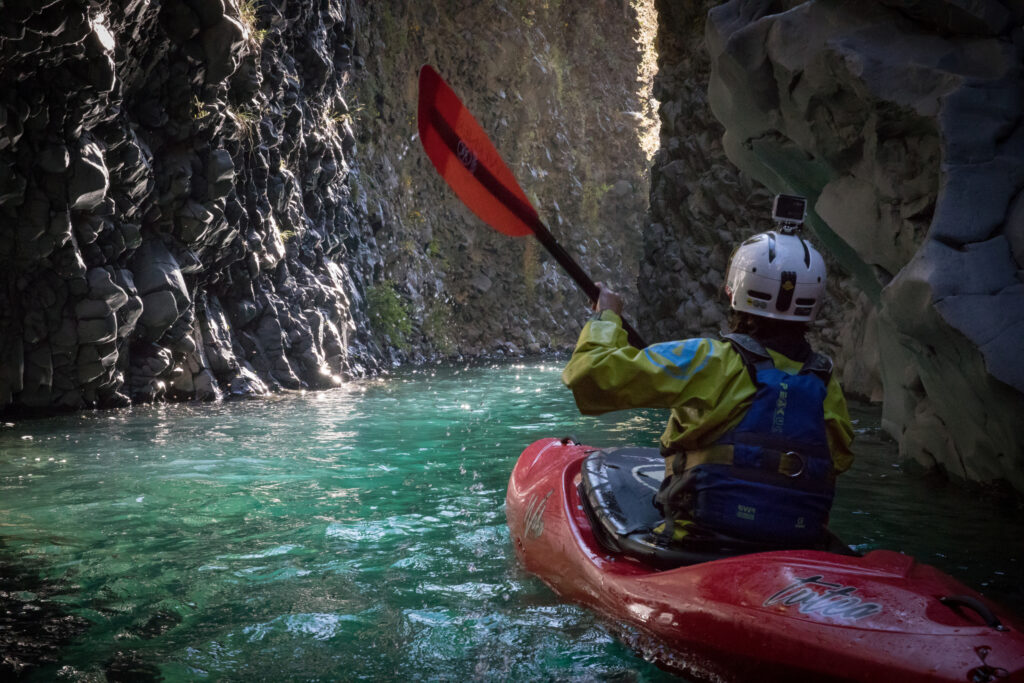
Story • Sal Montgomery • Jan 21, 2022
Pursuit of Place
Finding purpose and community on the wild rivers of Chile
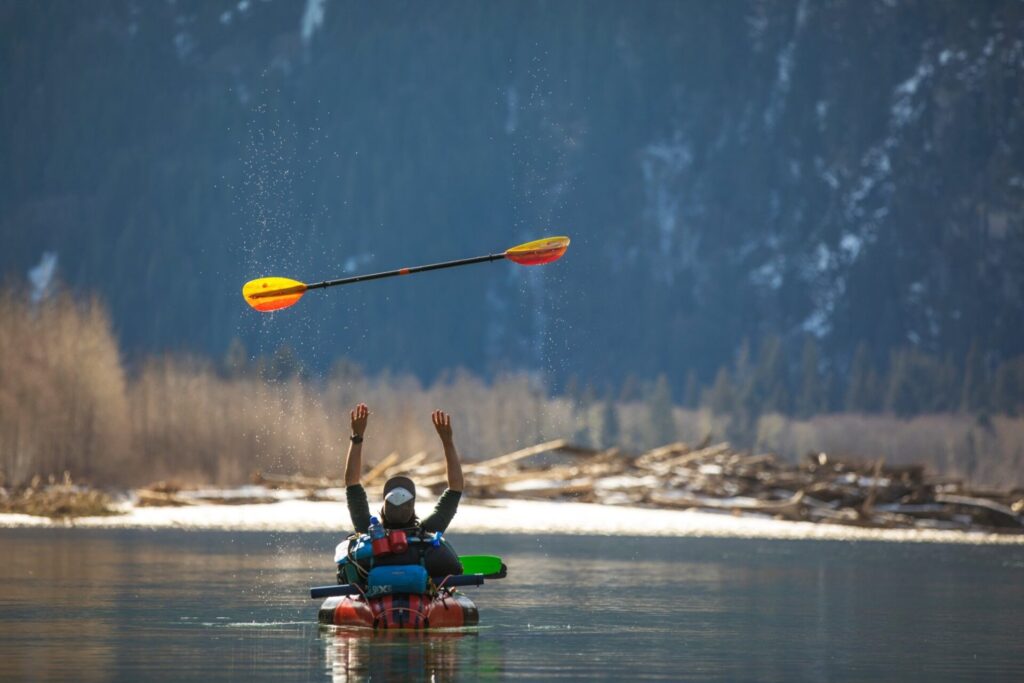
Story • Carmen Kuntz • Oct 20, 2021
Into the Crystal Current
Packrafting & ski touring British Columbia’s Coast Mountains
